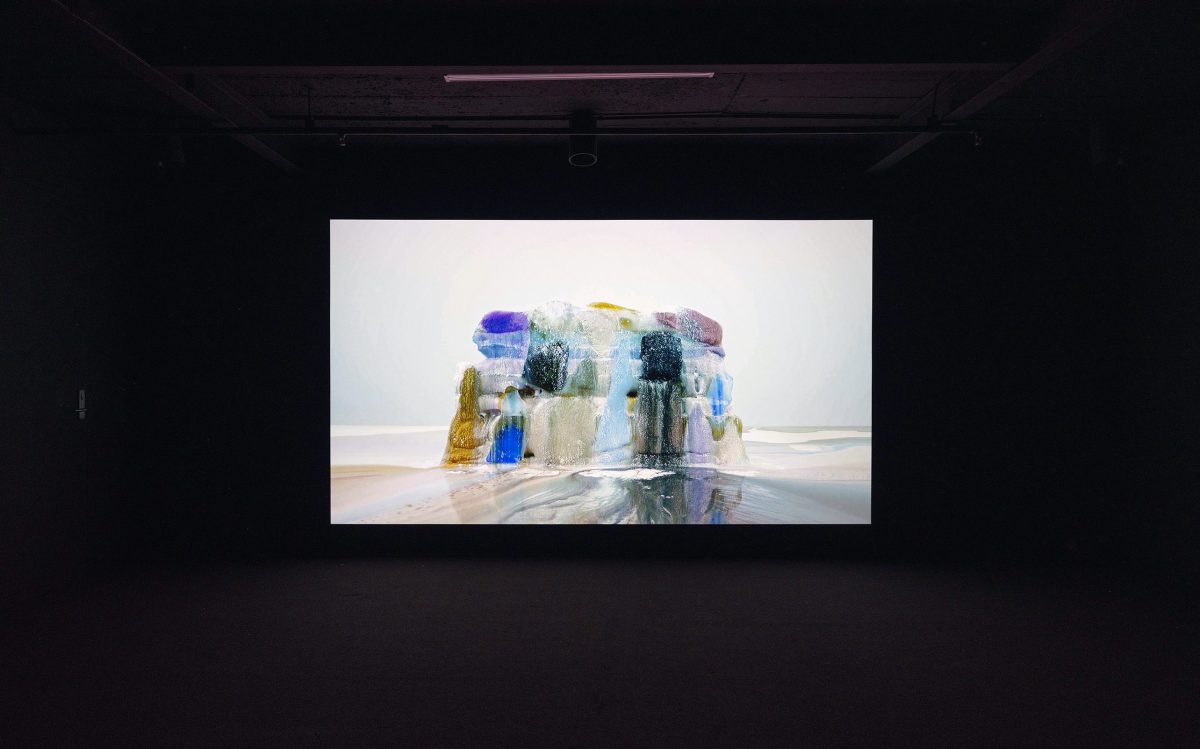In this post-digital age, what value can be placed on the installation of video art, especially single channel and silent works, when they could be experienced via the internet?
When the Director of Brisbane’s Institute of Modern Art (IMA), Robert Leonard, was asked whether the programming of a Singaporean artist was designed to coincide with the Lunar New Year celebrations in the precinct, he replied, ‘It was incidental… I thought it was a work that would engage a wide audience – I was certainly engaged.’
With Brisbane temperatures consistently soaring to between 30 and 40 degrees celsius, the appeal of a monumental depiction of ice melting would be difficult to dispute.
Avalanche comprises a screening of Avalanche II, a single-channel video made by Dawn Ng in 2017. The sequence tantalises with a vibrant palette mixed from hues that may have been considered subtle if separated. The most striking aspect of this artwork may be its movement of water and subsequent mixing of colour. This appears to be a metaphor for a coalescence of memories and a distortion of perceptions.
Ng has, through a number of interviews, made clear her intentions to capture the “elastic[ity]” of time, as governed by the emotions of those who are experiencing its passing. Mortality is also affectingly conveyed through this work.
The objects she refers to as “clocks” are meticulously crafted through the suspension of pigment in ice. The compositions are laid through repetitive pourings and freezings. Frozen forms of varying dimensions are also prepared separately and then sedimented into the sculptures. In Avalanche II, these present as shapes within an evolving picture plane. The static vantage point offered by the time-lapse camera enables a cross-section to be viewed. According to principles posited by Leon Battista Alberti, author of De Pictura (On Painting) (1435), audiences are offered a window.
Avalanche may be considered a revision of the rhetoric of painting. 水墨画 (Chinese ink painting) involved applying pigment in washes. Prior to the intervention of the literati, who believed it to be a distraction, colour was a tenet.
For this reviewer, Ng’s artwork could also meet the criteria for a portrait. After all, each of us is physically composed of approximately 60% water. It further brings to mind ideas investigated by US science-fiction writer Philip K Dick, who proposed that we are metaphysically made up of memories. On the other hand, Avalanche II could present as a landscape, partly owing to the size of the projection at the IMA.
To “colour”, as in add variation, or to “taint”, as in spoil… both have strong connotations in the English language. This is irrespective of whether the metaphors are applied to a memory, a person or an environment. Avalanche II could be considered to do all of these simultaneously.
Read: Exhibition review: Yhonnie Scarce: The Light of Day, Art Gallery of WA
The artwork is irrefutably effusive. The thoughts it may evoke would depend on the viewer. A particularly parched person, for instance, may begin salivating for a popsicle. Others could contemplate the inertia of time demonstrated through the imminent demise of the ice construction. In this way, Avalanche may tap into a primordial fear held by many. Despite consisting of a silent, single-channel video, the exhibition may evoke an avalanche of emotions.
Dawn Ng: Avalanche is on view at the Institute of Modern Art until 18 April 2024.





